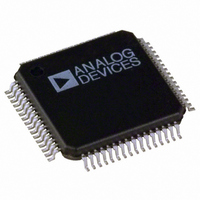ADE5569ASTZF62 Analog Devices Inc, ADE5569ASTZF62 Datasheet - Page 72

ADE5569ASTZF62
Manufacturer Part Number
ADE5569ASTZF62
Description
IC METER/8052/RTC/LCD DRV 64LQFP
Manufacturer
Analog Devices Inc
Datasheet
1.ADE5569ASTZF62-RL.pdf
(156 pages)
Specifications of ADE5569ASTZF62
Applications
Energy Measurement
Core Processor
8052
Program Memory Type
FLASH (62kB)
Controller Series
ADE55xx
Ram Size
2.25K x 8
Interface
I²C, SPI, UART
Number Of I /o
20
Voltage - Supply
3.135 V ~ 3.465 V
Operating Temperature
-40°C ~ 85°C
Mounting Type
Surface Mount
Package / Case
64-LQFP
Ic Function
Single Phase Energy Measurement IC
Supply Voltage Range
3.13V To 3.46V, 2.4V To 3.7V
Operating Temperature Range
-40°C To +85°C
Digital Ic Case Style
LQFP
No. Of Pins
64
Lead Free Status / RoHS Status
Lead free / RoHS Compliant
Lead Free Status / RoHS Status
Lead free / RoHS Compliant, Lead free / RoHS Compliant
Available stocks
Company
Part Number
Manufacturer
Quantity
Price
Company:
Part Number:
ADE5569ASTZF62
Manufacturer:
Analog Devices Inc
Quantity:
10 000
Company:
Part Number:
ADE5569ASTZF62-RL
Manufacturer:
Analog Devices Inc
Quantity:
10 000
ADE5166/ADE5169/ADE5566/ADE5569
ENERGY-TO-FREQUENCY CONVERSION
The ADE5166/ADE5169/ADE5566/ADE5569 also provide two
energy-to-frequency conversions for calibration purposes. After
initial calibration at manufacturing, the manufacturer or end
customer often verifies the energy meter calibration. One conve-
nient way to do this is for the manufacturer to provide an output
frequency that is proportional to the active power, reactive power,
apparent power, or I
frequency can provide a simple single-wire, optically isolated
interface to external calibration equipment. Figure 79 illustrates
the energy-to-frequency conversion in the ADE5166/ADE5169/
ADE5566/ADE5569.
Two digital-to-frequency converters (DFC) are used to generate
the pulsed outputs. When WDIV = 0 or 1, the DFC generates a
pulse each time 1 LSB in the energy register is accumulated. An
output pulse is generated when a CFxNUM/CFxDEN number of
pulses are generated at the DFC output. Under steady load con-
ditions, the output frequency is proportional to the active power,
reactive power, apparent power, or I
CFxSEL bits in the MODE2 register (Address 0x0C).
Both pulse outputs can be enabled or disabled by clearing or
setting the DISCF1 bit (Bit 1) and the DISCF2 bit (Bit 2) in the
MODE1 register (Address 0x0B), respectively.
Both pulse outputs set separate flags in the Interrupt Status 2 SFR
(MIRQSTM, Address 0xDD): CF1 (Bit 6) and CF2 (Bit 7). If the
CF1 enable bit (Bit 6) and CF2 enable bit (Bit 7) in the Interrupt
Enable 2 SFR (MIRQENM, Address 0xDA) are set, the 8052 core
has a pending ADE interrupt. The ADE interrupt stays active
until the CF1 or CF2 status bit is cleared (see the Energy
Measurement Interrupts section).
Pulse Output Configuration
The two pulse output circuits have separate configuration bits
in the MODE2 register (Address 0x0C). Setting the CFxSEL bits
to 0b00, 0b01, or 0b1X configures the DFC to create a pulse output
proportional to active power, reactive power, or apparent power
or I
I
*AVAILABLE ONLY IN THE ADE5169 AND ADE5569.
VA
rms
rms
VARMSCFCON
, respectively.
MODE2 REGISTER 0x0C
WATT
VAR*
Figure 79. Energy-to-Frequency Conversion
CFxSEL[1:0]
rms
under steady load conditions. This output
DFC
rms
, depending on the
CFxNUM
CFxDEN
÷
CFx PULSE
OUTPUT
Rev. C | Page 72 of 156
The selection between I
VARMSCFCON bit (Bit 3) in the MODE2 register (Address 0x0C).
With this selection, CF2 cannot be proportional to apparent power
if CF1 is proportional to I
apparent power if CF2 is proportional to I
Pulse Output Characteristic
The pulse output for both DFCs stays low for 90 ms if the pulse
period is longer than 180 ms (5.56 Hz). If the pulse period is
shorter than 180 ms, the duty cycle of the pulse output is 50%.
The pulse output is active low and should preferably be connected
to an LED, as shown in Figure 80.
The maximum output frequency with ac input signals at
full scale and CFxNUM = 0x00 and CFxDEN = 0x00 is
approximately 21.1 kHz.
The ADE5166/ADE5169/ADE5566/ADE5569 incorporate two
registers per DFC, CFxNUM[15:0] and CFxDEN[15:0], to set
the CFx frequency. These unsigned, 16-bit registers can be used
to adjust the CFx frequency to a wide range of values, scaling
the output frequency by 1/2
If 0 is written to any of these registers, 1 is applied to the register.
The ratio of CFxNUM/CFxDEN should be <1 to ensure proper
operation. If the ratio of the CFxNUM/CFxDEN registers is >1,
the register values are adjusted to a ratio of 1. For example, if the
output frequency is 1.562 kHz, and the content of CFxDEN is 0
(0x000), the output frequency can be set to 6.1 Hz by writing 0xFF
to the CFxDEN register.
ENERGY REGISTER SCALING
The ADE5166/ADE5169/ADE5566/ADE5569 provide measure-
ments of active, reactive, and apparent energy that use separate
paths and filtering for calculation. The difference in data paths can
result in small differences in LSB weight between active, reactive,
and apparent energy registers. These measurements are internally
compensated so that the scaling is nearly one to one. The relation-
ship between these registers is shown in Table 48.
Table 48. Energy Registers Scaling
Line Frequency = 50 Hz
Var = 0.9952 × watt
VA = 0.9978 × watt
Var = 0.9997 × watt
VA = 0.9977 × watt
Figure 80. CF Pulse Output
rms
CF
rms
and apparent power is done by the
Line Frequency = 60 Hz
Var = 0.9949 × watt
VA = 1.0015 × watt
Var = 0.9999 × watt
VA = 1.0015 × watt
16
, and CF1 cannot be proportional to
to 1 with a step of 1/2
V
DD
rms
.
16
.
Integrator
Off
Off
On
On













